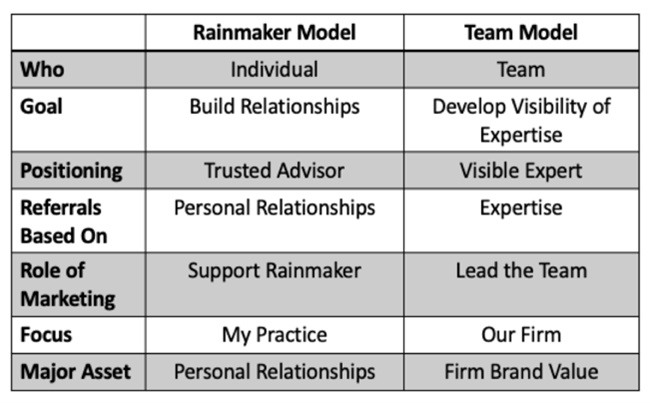The Changing World of Business Development
Turning Traditional Business Development on Its Head (Part I of II)
Business development (BD) used to be simple: do good work for existing clients, be active in your local community, and watch the referrals roll in. To be a successful rainmaker for a firm, all a professional needed was a little confidence, some networking skills, and perhaps the occasional educational presentation. But BD has changed, driven by changes in the behavior of professional services buyers. Rather than ask a colleague about a business question, they began using search engines. In one industry after another, including professional services, digital transformation has rocked traditional buying patterns and expectations. Of course, traditional face-to-face interaction has not disappeared, nor is it likely to. Instead, it is becoming just one possible path among several to winning new business. This article addresses two questions: 1) How should firm’s respond to the change and 2) How should the BD be structured?

Rethinking the Old Approach
For any professional services firm, new business is as essential as oxygen. Picking up new clients—and new work from existing clients—drives a firm forward and creates opportunities for both professional and business growth.
Unfortunately, however, bringing in new clients is a major challenge for many firms, often because they simply lack the necessary business development (BD) team structure. Their billable professionals are too busy working with existing clients to find and develop new prospects. Predictably, work slows down. Panic sets in, followed by a mad scramble to find qualified leads and close new engagements. And then this cycle repeats itself.
There is a better way; and it starts with turning the traditional BD model on its head. To understand why, start with a basic definition of business development, and how it has changed. Business development encompasses the interrelated processes of identifying, nurturing, and acquiring new clients and business opportunities. In the world of professional services, BD includes such marketing and sales functions as lead generation, nurturing, opportunity qualification, proposal preparation, and closing.
How BD is Evolving
Business development used to be simple: do good work for existing clients, be active in your local community, and watch the referrals roll in. To be a successful rainmaker for a firm, all a professional needed was a little confidence, some networking skills, and perhaps the occasional educational presentation.
But BD has changed, driven by changes in the behavior of professional services buyers. Rather than ask a colleague about a business question, they began using search engines. In one industry after another, including professional services, digital transformation has rocked traditional buying patterns and expectations. Of course, traditional face-to-face interaction has not disappeared, nor is it likely to. Instead, it is becoming just one possible path among several to winning new business.
So how should a modern professional services firm respond? And what is the best way to structure your BD team?
Choosing Your BD Team Structure
While the ways that firms structure their BD function vary, two basic approaches tend to dominate. The first is the Rainmaker Model, in which individual seller-doers drive BD. Their goals are to build long-term relationships with and become trusted advisors to the clients whom they bring into the firm. These personal relationships, in turn, eventually generate new referrals. Meanwhile, the role of marketing or BD personnel is to support the rainmaker’s activities, often at their direction, by arranging appointments, managing events, and assisting with proposals. The end product is a portfolio of clients who are loyal to the rainmaker.

When you factor in the emerging patterns of buyer behavior, however, the limitations of the rainmaker model become obvious. The blend of talents and activities needed to succeed at both digital and traditional marketing is daunting. How can one billable professional find the time or gain the specialized skills necessary to succeed? And what happens if that individual moves to a competitor? Their personal relationships probably leave with them. Last, but not least, consider the thorny challenge of cross-selling the firm’s services. Far too often, it simply does not happen in the traditional model. Since each rainmaker focuses on their own practice, it is almost inevitable that practices become siloed.
Given these limitations, it is not surprising that an alternative model has emerged: the Team Model, which features multiple people collaborating to implement a broader strategic BD plan. In this model, the individual fee-earning professional is just one member of a BD team that includes diverse skill sets and roles. The professional’s main goal is not to develop individual relationships, but rather to showcase the firm’s full range of expertise to solve clients’ problems.
Why focus on expertise rather than relationships? The answer is simple: expertise is buyers’ number one factor in selecting a firm. While many clients value relationships, finding a firm that can solve their critical business problems is even more important.
In this model, the role of leadership falls to either the marketing or BD function, which assembles and manages the team, and plans and coordinates multi-channel activities. Team members may also include fee-earners themselves. Significantly, roles within the team are defined by skill sets and interest, not titles.
Because the team is focused on building the value of the whole firm, not just a particular practice, the team can make more strategic decisions about priorities and resource allocation. This also means that when a professional leaves your firm, the value they have built for your firm does not walk out the door with them.
A Final Thought
Structuring a successful BD team can be a challenge for many firms, especially as buyer behavior keeps evolving in today’s digital-driven marketplace. Because the Team Model gives most firms a better, more strategic way of structuring the BD function, it may be worth rethinking how you go about bringing in new business.
Lee W. Frederiksen, PhD, is Managing Partner at Hinge, the leading branding and marketing firm for the professional services. Hinge conducts groundbreaking research into high-growth firms and offers a complete suite of services for firms that want to become more visible and grow.
Dr. Frederiksen can be contacted at (703) 391-8870 or by e-mail to LFrederiksen@hingemarketing.com.









